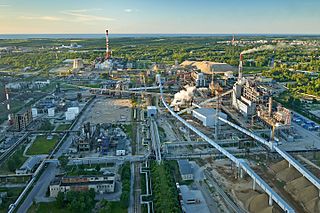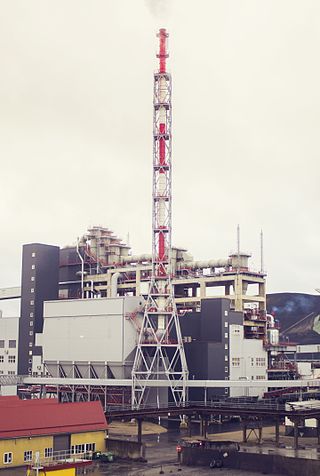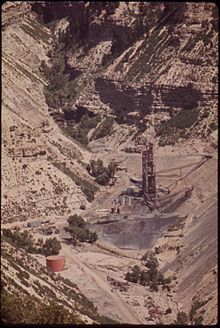Shale oil is an unconventional oil produced from oil shale rock fragments by pyrolysis, hydrogenation, or thermal dissolution. These processes convert the organic matter within the rock (kerogen) into synthetic oil and gas. The resulting oil can be used immediately as a fuel or upgraded to meet refinery feedstock specifications by adding hydrogen and removing impurities such as sulfur and nitrogen. The refined products can be used for the same purposes as those derived from crude oil.

The Shell in situ conversion process is an in situ shale oil extraction technology to convert kerogen in oil shale to shale oil. It is developed by the Shell Oil Company.

Tosco was an independent US based petroleum refining and marketing corporation based in Stamford, Connecticut. It was founded in 1955 in Santa Monica, California by A&P heir Huntington Hartford, and originally focused on extracting oil from oil shale and developing alternative energy sources.
Petrosix is the world's largest surface oil shale pyrolysis retort with an 11 metres (36 ft) diameter vertical shaft kiln, operational since 1992. It is located in São Mateus do Sul, Brazil, and it is owned and operated by the Brazil energy company Petrobras. Petrosix means also the Petrosix process, an externally generated hot gas technology of shale oil extraction. The technology is tailored to Irati oil shale formation, a Permian formation of the Paraná Basin.

The oil shale industry is an industry of mining and processing of oil shale—a fine-grained sedimentary rock, containing significant amounts of kerogen, from which liquid hydrocarbons can be manufactured. The industry has developed in Brazil, China, Estonia and to some extent in Germany and Russia. Several other countries are currently conducting research on their oil shale reserves and production methods to improve efficiency and recovery. Estonia accounted for about 70% of the world's oil shale production in a study published in 2005.

Shale oil extraction is an industrial process for unconventional oil production. This process converts kerogen in oil shale into shale oil by pyrolysis, hydrogenation, or thermal dissolution. The resultant shale oil is used as fuel oil or upgraded to meet refinery feedstock specifications by adding hydrogen and removing sulfur and nitrogen impurities.
Oil shale economics deals with the economic feasibility of oil shale extraction and processing. Although usually oil shale economics is understood as shale oil extraction economics, the wider approach evaluates usage of oil shale as a whole, including for the oil-shale-fired power generation and production of by-products during retorting or shale oil upgrading processes.

The history of the oil shale industry started in ancient times. The modern industrial use of oil shale for oil extraction dates to the mid-19th century and started growing just before World War I because of the mass production of automobiles and trucks and the supposed shortage of gasoline for transportation needs. Between the World Wars oil shale projects were begun in several countries.
Oil shale in China is an important source of unconventional oil. A total Chinese oil shale resource amounts of 720 billion tonnes, located in 80 deposits of 47 oil shale basins. This is equal to 48 billion tonnes of shale oil. At the same time there are speculations that the actual resource may even exceed the oil shale resource of the United States.
The TOSCO II process is an above ground retorting technology for shale oil extraction, which uses fine particles of oil shale that are heated in a rotating kiln. The particularity of this process is that it use hot ceramic balls for the heat transfer between the retort and a heater. The process was tested in a 40 tonnes per hour test facility near Parachute, Colorado.

The Galoter process is a shale oil extraction technology for the production of shale oil, a type of synthetic crude oil. In this process, the oil shale is decomposed into shale oil, oil shale gas, and spent residue. Decomposition is caused by mixing raw oil shale with hot oil shale ash generated by the combustion of carbonaceous residue (semi-coke) in the spent residue. The process was developed in the 1950s, and it is used commercially for shale oil production in Estonia. There are projects for further development of this technology and expansion of its usage, e.g., in Jordan and the USA.
The Alberta Taciuk process is an above-ground dry thermal retorting technology for extracting oil from oil sands, oil shale and other organics-bearing materials, including oil contaminated soils, sludges and wastes. The technology is named after its inventor William Taciuk and the Alberta Oil Sands Technology and Research Authority.
The Paraho process is an above ground retorting technology for shale oil extraction. The name "Paraho" is delivered from the words "para homem", which means in Portuguese "for mankind".
The gas combustion retort process was an above-ground retorting technology for shale oil extraction. It was a predecessor of the Paraho and Petrosix processes, and modern directly heated oil shale retorting technologies in general.
In the United States, synthetic fuels are of increasing importance due to the price of crude oil, and geopolitical and economic considerations.
The Nevada–Texas–Utah retort process was an above-ground shale oil extraction technology to produce shale oil, a type of synthetic crude oil. It heated oil shale in a sealed vessel (retort) causing its decomposition into shale oil, oil shale gas and spent residue. The process was developed in the 1920s and used for shale oil production in the United States and in Australia. The process was simple to operate; however, it was ceased from the operation because of a small capacity and labor extensiveness.
The Superior multimineral process is an above ground shale oil extraction technology designed for production of shale oil, a type of synthetic crude oil. The process heats oil shale in a sealed horizontal segmented vessel (retort) causing its decomposition into shale oil, oil shale gas and spent residue. The particularities of this process is a recovery of saline minerals from the oil shale, and a doughnut-shape of the retort. The process is suitable for processing of mineral-rich oil shales, such as in the Piceance Basin. It has a relatively high reliability and high oil yield. The technology was developed by the American oil company Superior Oil.
The Union process was an above ground shale oil extraction technology for production of shale oil, a type of synthetic crude oil. The process used a vertical retort where heating causes decomposition of oil shale into shale oil, oil shale gas and spent residue. The particularity of this process is that oil shale in the retort moves from the bottom upward to the top, countercurrent to the descending hot gases, by a mechanism known as a rock pump. The process technology was invented by the American oil company Unocal Corporation in late 1940s and was developed through several decades. The largest oil shale retort ever built was the Union B type retort.
Oil shale in Morocco represents a significant potential resource. The ten known oil shale deposits in Morocco contain over 53.381 billion barrels of shale oil. Although Moroccan oil shale has been studied since the 1930s and several pilot plants have extracted shale oil from the local formations, commercial extraction was not underway as of 2011.
The history of the oil shale industry in the United States goes back to the 1850s; it dates back farther as a major enterprise than the petroleum industry. But although the United States contains the world's largest known resource of oil shale, the US has not been a significant producer of shale oil since 1861. There were three major past attempts to establish an American oil shale industry: the 1850s; in the years during and after World War I; and in the 1970s and early 1980s. Each time, the oil shale industry failed because of competition from cheaper petroleum.





